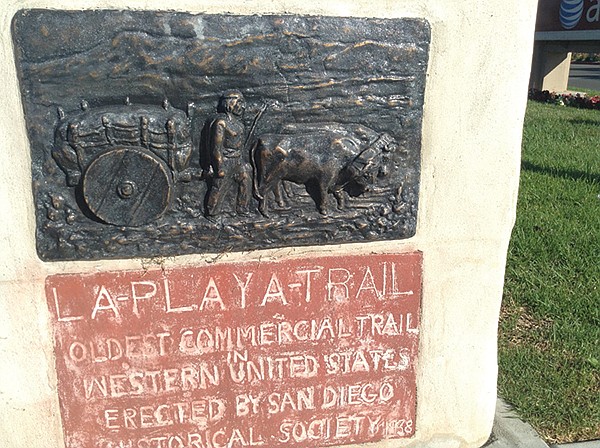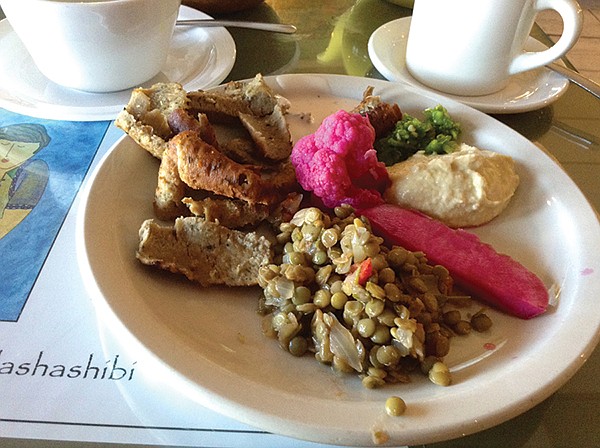 Facebook
Facebook
 X
X
 Instagram
Instagram
 TikTok
TikTok
 Youtube
Youtube

Whew. Hot day out here on the La Playa Trail.

La Playa Trail? Just the oldest commercial trail in the Western United States. ’Course we know it as Rosecrans Street. I notice this li’l historical marker right by the 28 bus stop.
I check the 28 timetable. Man. Another half hour. Sun’s beating down. My kingdom for a snack! And something cool to drink.
I go looking up Midway. And here at a complex called “Midway Village,” there is a bunch. Wings and Things. Places like that.
But tucked in behind Wings and Things, something more interesting. Fairouz, Mediterranean. “Lunch and dinner buffet,” reads the sign painted on the window. “Vegetarian and meat dishes.”
Oh, man. A buffet. That would be perfect. But still on? I mean, it’s past half past two. My hope is that they have some people sitting at tables outside, eating away.
I head in to what looks like an art gallery as much as a restaurant. Colorful paintings line walls. Lots of them.
But the most beautiful picture for yours truly is this long, shiny row of chafing dishes steaming away with dishes ranging from purple (pickled cauliflower) to orange (chicken saffron) to brown (mujadara: lentils, groats, sautéed onions), to yellow (moussaka, a sort of shepherd’s pie, but all veggie). Just reading the labels here... Not sure what they all mean, but they smell great.

A sign reads, “Lunch buffet, $11.99.”
“Is it still on?” I ask this middle-aged guy. He’s stirring one of the chafing dishes.
“Certainly,” he says. “All day. It changes to dinner buffet around four. Then it costs $15.99. We add dishes like lamb shank. Please. Take a plate.”
Hmm... Twelve bucks. But you can come back for seconds and thirds. And the line of dishes seems to go on forever. I see lots of dishes labeled “vegetarian” and “vegan,” too. And it all has the feel of Arabic comfort food. Last patch is sweet desserts. Can’t wait for that part.
The gentleman’s name is Sami al Nashashibi.
“So, are you the artist?” I ask.
“No. That is my brother Ibrahim. He is up in L.A. right now opening an exhibition of his paintings. He is very successful. He is lucky to have a brother who can look after his restaurant.”
Sami cracks a smile. Actually, the effect of all the paintings is they make the dishes in front of them look pretty romantic. The meats’ and veggies’ colors reflect in the mythical views of ancient cities and street scenes.
“Any recommendations?” I ask the gal at the cash register. Turns out she’s Sami’s daughter, Haya.
“Well, you should start off with the avgolemono,” she says.
“What again?”
“Avgolemono. This is Greek. Chicken lemon soup. It’s a house specialty.”
And so it starts. My shameless series of processions to the buffet.
The soup is thick but refreshing, and great with the heated pita bread that Haya brings. Then I grab a big plate and go for more yellow: moussaka. It’s comfort-food delish. Eggplant-and-potato-based kinda pie out of the old Ottoman empire with, Haya says, a béchamel sauce and saffron oozing over the top. “The Greeks would have this hot. In the Middle East, we prefer it cool,” she says. “Our family is from Jerusalem. We’re Palestinian.”
Huh. I have loaded some delicious spinach, chicken saffron, and a pile of zucchinis in a brown sauce onto this plate. “The Lebanese brought this saffron chicken from Morocco, originally,” says Haya. “It’s everywhere now.”
Next trip it’s a pile of purple pickled vegetables and lentil salad, plus a chopped jalapeño mix and a pile of tender gyros lamb-and-beef meat. And a mound of their house mayo (“red vinegar, feta, olive oil, and oregano,” says Haya). I like that feta add.
One thing’s for sure: this is vegetarian and vegan heaven. Meats are in the minority here.
It’s all good standard food with a Middle-Eastern twist. But, have to say, it’s the dessert trip that really rocks. They have six of them, each kinda original. Like carrots and coconut. My three faves: farina, a li’l chunk of wheat cake soaked in honey, like baklava. almost; a rice pudding with rose water; and (drum roll!) barley and raisins with cinnamon and honey. Sabroso!
Maybe the most important thing I learn is about mint tea. I ordered a pot ($2.50) and, man, it’s so refreshing. “It’s a Jerusalem thing,” says Sami. “We just infuse mint leaves in boiling water. It is very good for settling your stomach. Everybody in Jerusalem — Arabs and Jews alike — drinks it before going to bed.”
Haya says her dad’s from a pretty prominent Palestinian Jerusalem family. “Our great great whatever grandfather was Prince Naser al-Din al-Nashashibi,” she says.
Wow. A prince? Turns out he came to Jerusalem from Egypt in 1469. Family’s lived there ever since. “My father’s family still lives in the family house on Via Dolorosa, where Jesus carried the cross.”
Has she been to the house on Via Dolorosa? She nods. “We went back when I was 14. My mom wanted us to stay there in Jerusalem, go to school. And it was lovely. But their ways are just different. My uncles came back home for lunch every day. And it would be a long lunch. Then a siesta. Then back to work in the cool of the evening. My problem was that I was already too American. I missed the pace of living here. I missed my friends. Here I belong. There I was a visitor.”
Before I go, I take a look around her uncle’s paintings. Beautiful. No touch of bitterness you might expect from a Palestinian living in Israel. Sami says his brother Ibrahim is trying to show Jerusalem as “the city of love, the mother of humanity.”
Note to self: Late lunches? Fairouz.


Whew. Hot day out here on the La Playa Trail.

La Playa Trail? Just the oldest commercial trail in the Western United States. ’Course we know it as Rosecrans Street. I notice this li’l historical marker right by the 28 bus stop.
I check the 28 timetable. Man. Another half hour. Sun’s beating down. My kingdom for a snack! And something cool to drink.
I go looking up Midway. And here at a complex called “Midway Village,” there is a bunch. Wings and Things. Places like that.
But tucked in behind Wings and Things, something more interesting. Fairouz, Mediterranean. “Lunch and dinner buffet,” reads the sign painted on the window. “Vegetarian and meat dishes.”
Oh, man. A buffet. That would be perfect. But still on? I mean, it’s past half past two. My hope is that they have some people sitting at tables outside, eating away.
I head in to what looks like an art gallery as much as a restaurant. Colorful paintings line walls. Lots of them.
But the most beautiful picture for yours truly is this long, shiny row of chafing dishes steaming away with dishes ranging from purple (pickled cauliflower) to orange (chicken saffron) to brown (mujadara: lentils, groats, sautéed onions), to yellow (moussaka, a sort of shepherd’s pie, but all veggie). Just reading the labels here... Not sure what they all mean, but they smell great.

A sign reads, “Lunch buffet, $11.99.”
“Is it still on?” I ask this middle-aged guy. He’s stirring one of the chafing dishes.
“Certainly,” he says. “All day. It changes to dinner buffet around four. Then it costs $15.99. We add dishes like lamb shank. Please. Take a plate.”
Hmm... Twelve bucks. But you can come back for seconds and thirds. And the line of dishes seems to go on forever. I see lots of dishes labeled “vegetarian” and “vegan,” too. And it all has the feel of Arabic comfort food. Last patch is sweet desserts. Can’t wait for that part.
The gentleman’s name is Sami al Nashashibi.
“So, are you the artist?” I ask.
“No. That is my brother Ibrahim. He is up in L.A. right now opening an exhibition of his paintings. He is very successful. He is lucky to have a brother who can look after his restaurant.”
Sami cracks a smile. Actually, the effect of all the paintings is they make the dishes in front of them look pretty romantic. The meats’ and veggies’ colors reflect in the mythical views of ancient cities and street scenes.
“Any recommendations?” I ask the gal at the cash register. Turns out she’s Sami’s daughter, Haya.
“Well, you should start off with the avgolemono,” she says.
“What again?”
“Avgolemono. This is Greek. Chicken lemon soup. It’s a house specialty.”
And so it starts. My shameless series of processions to the buffet.
The soup is thick but refreshing, and great with the heated pita bread that Haya brings. Then I grab a big plate and go for more yellow: moussaka. It’s comfort-food delish. Eggplant-and-potato-based kinda pie out of the old Ottoman empire with, Haya says, a béchamel sauce and saffron oozing over the top. “The Greeks would have this hot. In the Middle East, we prefer it cool,” she says. “Our family is from Jerusalem. We’re Palestinian.”
Huh. I have loaded some delicious spinach, chicken saffron, and a pile of zucchinis in a brown sauce onto this plate. “The Lebanese brought this saffron chicken from Morocco, originally,” says Haya. “It’s everywhere now.”
Next trip it’s a pile of purple pickled vegetables and lentil salad, plus a chopped jalapeño mix and a pile of tender gyros lamb-and-beef meat. And a mound of their house mayo (“red vinegar, feta, olive oil, and oregano,” says Haya). I like that feta add.
One thing’s for sure: this is vegetarian and vegan heaven. Meats are in the minority here.
It’s all good standard food with a Middle-Eastern twist. But, have to say, it’s the dessert trip that really rocks. They have six of them, each kinda original. Like carrots and coconut. My three faves: farina, a li’l chunk of wheat cake soaked in honey, like baklava. almost; a rice pudding with rose water; and (drum roll!) barley and raisins with cinnamon and honey. Sabroso!
Maybe the most important thing I learn is about mint tea. I ordered a pot ($2.50) and, man, it’s so refreshing. “It’s a Jerusalem thing,” says Sami. “We just infuse mint leaves in boiling water. It is very good for settling your stomach. Everybody in Jerusalem — Arabs and Jews alike — drinks it before going to bed.”
Haya says her dad’s from a pretty prominent Palestinian Jerusalem family. “Our great great whatever grandfather was Prince Naser al-Din al-Nashashibi,” she says.
Wow. A prince? Turns out he came to Jerusalem from Egypt in 1469. Family’s lived there ever since. “My father’s family still lives in the family house on Via Dolorosa, where Jesus carried the cross.”
Has she been to the house on Via Dolorosa? She nods. “We went back when I was 14. My mom wanted us to stay there in Jerusalem, go to school. And it was lovely. But their ways are just different. My uncles came back home for lunch every day. And it would be a long lunch. Then a siesta. Then back to work in the cool of the evening. My problem was that I was already too American. I missed the pace of living here. I missed my friends. Here I belong. There I was a visitor.”
Before I go, I take a look around her uncle’s paintings. Beautiful. No touch of bitterness you might expect from a Palestinian living in Israel. Sami says his brother Ibrahim is trying to show Jerusalem as “the city of love, the mother of humanity.”
Note to self: Late lunches? Fairouz.